In the field of Agile coaching, the question of the coach posture often arises. Should I rather be low posture (questioning, taking a step back) or rather in high posture (advice, solution)? This is also a subject that we address in my personal responsibility training.
It's when Matilda Russo offers me to collaborate to respond to a customer request that I am intrigued. Indeed, the latter wishes Improve the advisory posture of its employees“, which seems to me to be a rather interesting subject to study.
Now, how do I respond in a relevant way when I'm more used to sharing around the low posture? Well Challenge accepted ! 🙂
I will share with you here what we proposed during a half-day specific to the consulting theme with all my journey, from the design to the actual unfolding!
Let's go ! 😉
Context
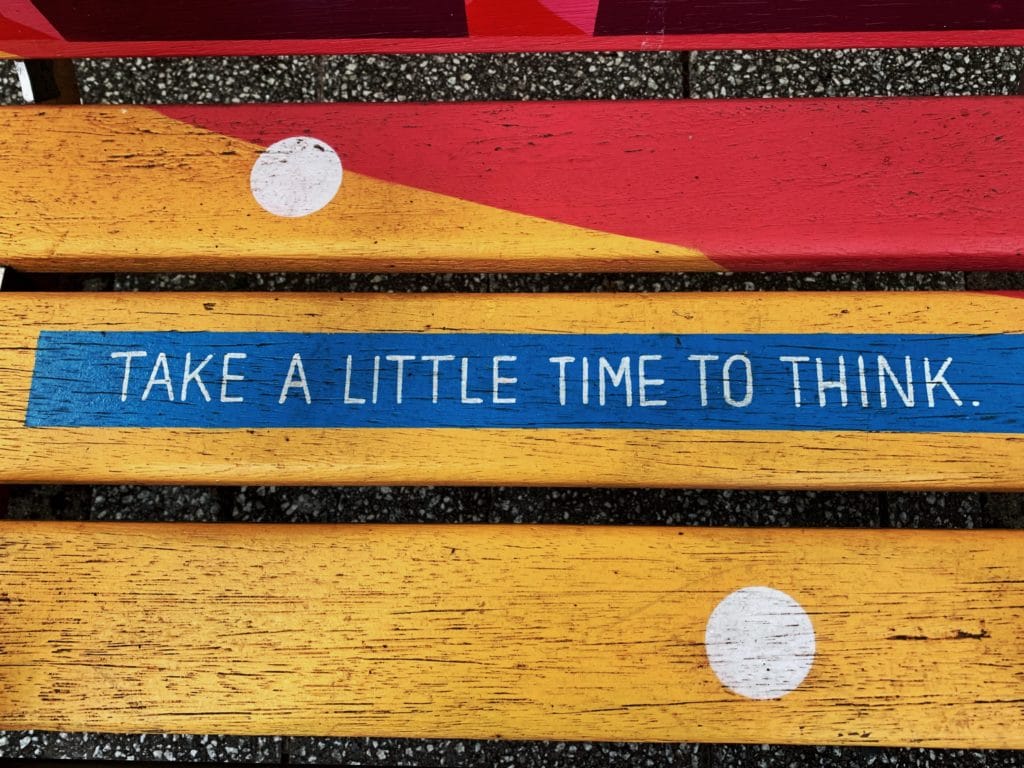
After a first exchange with the client to better understand the context of his request, I obtain the initial information necessary for my reflection:
- Number of persons : 9 (including a manager)
- Duration : 3 hours
- Format : Face-to-face
- Intention : Make its collaborators more pro-active in their advisory position and improve the quality of their responses to their customers.
Questions
The requester seemed to want us to provide good consulting practices so that they could be applied by his collaborators. I often have the impression that this does not have much interest, or even that it can be counterproductive:
- In effect, list good practices on a vague subject as advice often remains theoretical and therefore tends to enter through one ear and exit through the other. I could already see people saying or thinking " it's obvious what you tell us“, “ we already know“. Meven if that does not mean that they apply it, we agree! 😛
- The risk would be believe that it is enough to apply these rules to make it work. Even if we can consider that the outlines are universal, it is no less true that the devil is in the details. Each person is unique and human relationships are much more complex than one might think.
Note: I am not saying however that it has "no" interest but I am convinced that it is in the form that we can maximize the impact of the content. We could therefore bring out the content of the participants rather than the reverse, even if it means being less exhaustive but more relevant.
It is therefore this direction that I will explore.
Note: This is a way of avoiding confusion around the term (which is opposed to coaching for example). We then stay on something concrete and actionable for the participants.
Design

As usual, I start first with the time constraint. We have 3 hours at our disposal so in terms of structure, we can start with an introduction (ice-breaker), a conclusion, a break and potentially 2 work phases.
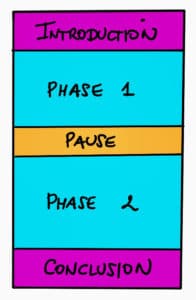
So let's go into each section a little more in detail.
Intro / Icebreaker: Animal Totem
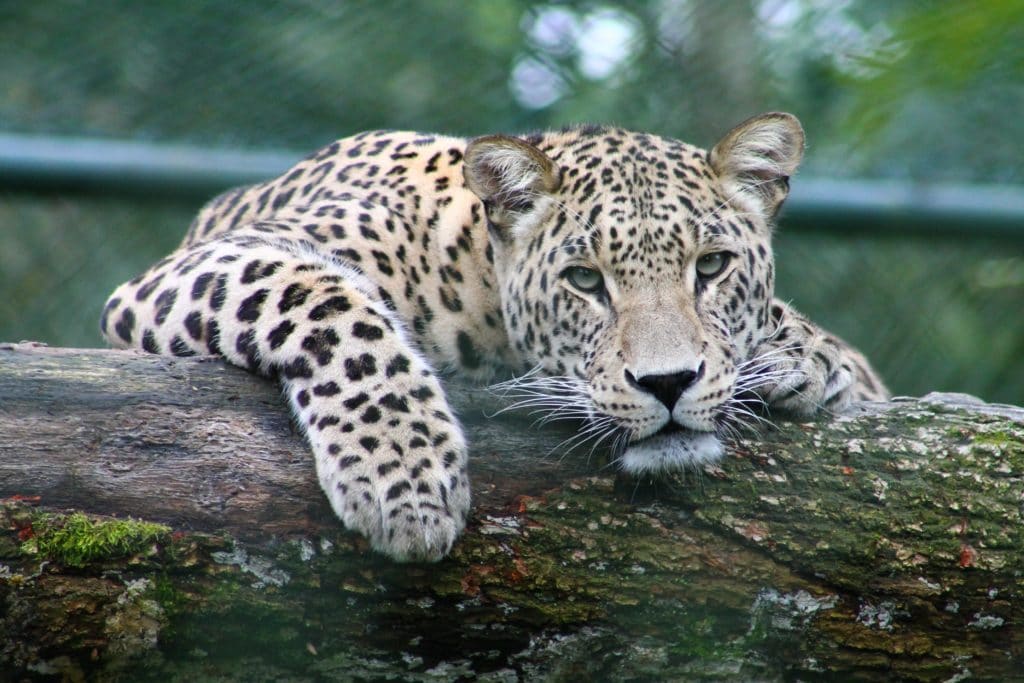
The people having not seen each other for a long time, Mathilde proposed to animate a Animal Totem to break the ice. Why not, theworkshop is fast, fun and light and would allow us to get off to a smooth start. The main idea is for each person to define a combination of an animal and an adjective representing it.
Note: A bit like the concept of Chinese portraits (“if I were an animal, I would be…”, “if I were an adjective, I would be…”).
The important thing for me was above all to have a good consistency with the theme that we wanted to address. Indeed, I do not want to do activities for the simple pleasure of doing them (especially for icebreakers who do not always have very good press) but because they can contribute to the final objective. So there is always a debrief at stake.
The idea will be to talk about the knowledge of self and others so that you can then work on the relationship. I will readjust to what will happen during the session 🙂
Remembrance of good advice
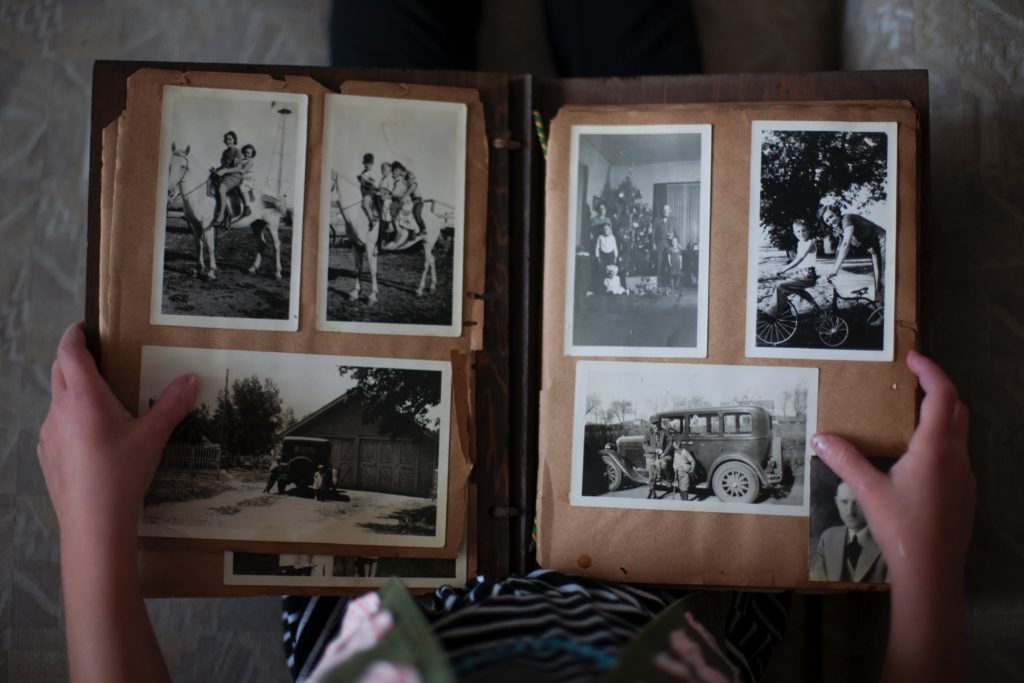
Indeed, the interest of stories and memories is that they represent an integral personal experience soliciting the 3 energy centers of the personality:
- There head : by the formulation of the experience, allowing to take a step back, to make logical paths and to structure the information
- THE heart : by remembering both positive and negative emotions, specific to the person
- THE body : by the memory of bodily sensations linked to the interaction experienced
Note: The theme of the 3 energy centers is covered in the free Manager training modules with his Personality built in collaboration with SuperTilt.
We would thus obtain specific stories to the people present in the group allowing us to identify things that are really important for them. The elements mentioned will therefore potentially have a better chance of being implemented subsequently.
- (15′) By sharing their story each in turn with a person To whom questions and note important information and a person B who tells his history
- (5′) From consolidate the coherent elements of the stories of the pair
- (20′) Then share to the rest of the group afterwards
The concept of animation is therefore reversed compared to the initial request: we would start from concrete and specific experiences to go back to more general good practices.
Empathy Map

The previous section was mainly focused on the relationship between the 2 parties and how to interact to obtain better results.
I wanted to press the dimension of knowledge of the other, of the client, and what came to mind was theEmpathy Map. Indeed, not only does it appear as an additional tool (therefore reassuring in its own way) but it is in my opinion an excellent conversation medium for the sequel.
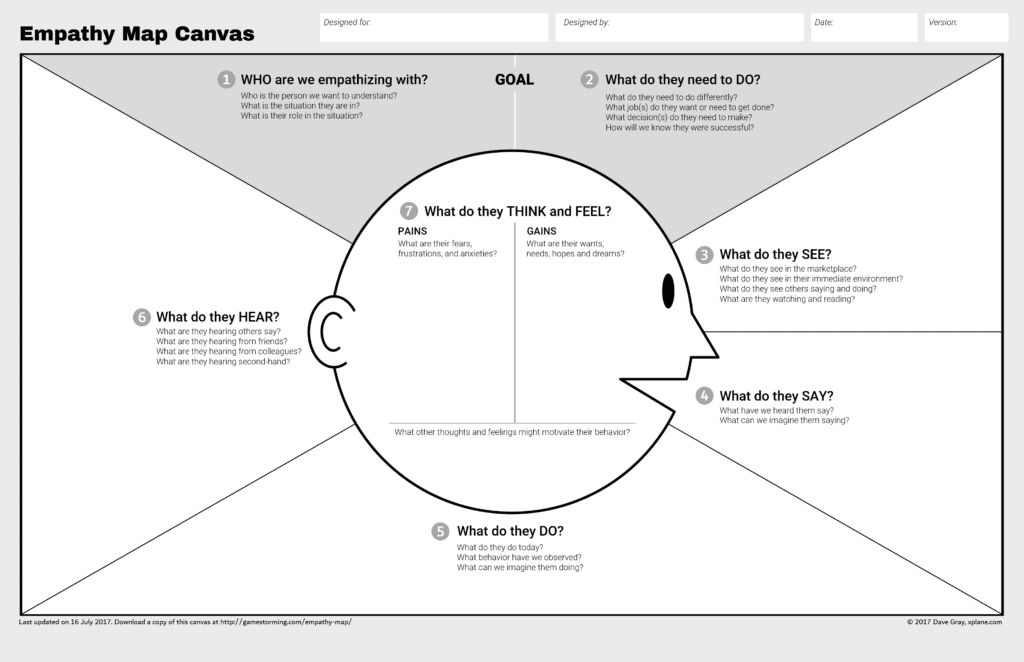
The pdf version can be found here.
The sequence would then be:
- (15′) to fill individually each person this canvas on a particular client
- (20′) of introduce your client to another person to identify ways to better interact with him
- (20′) then share their learnings to the rest of the group
The general idea being to help them go further in their knowledge of the other by asking the right questions and in opening up to an outside view.
Peer integration
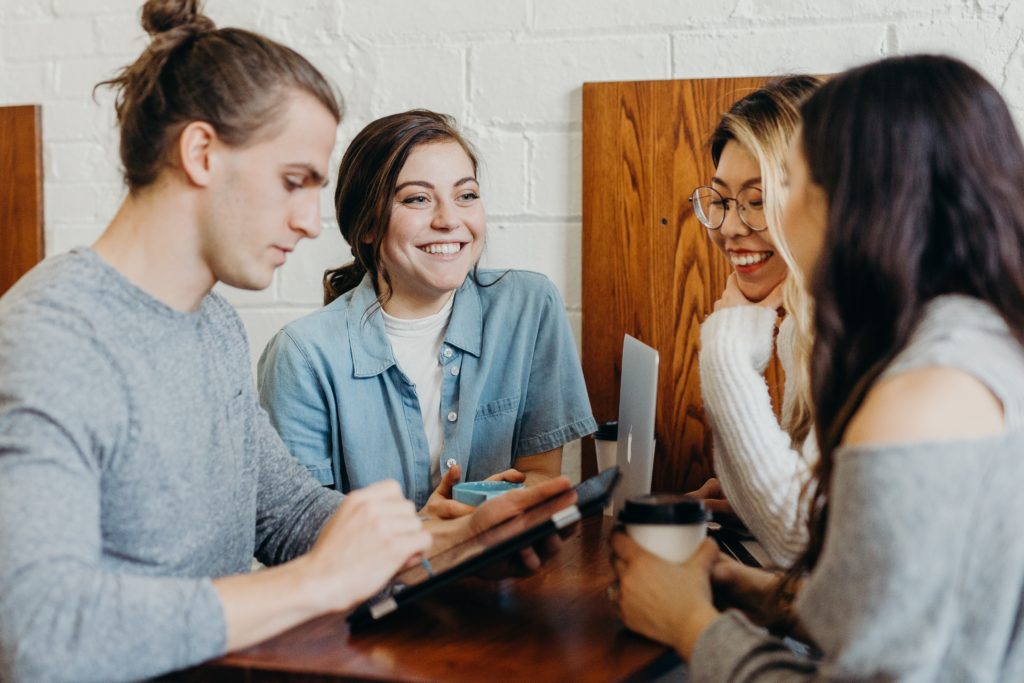
This sequence is quite simple in terms of animation but seems to me more and more relevant in the formations that I animate.
Indeed, it is a moment when I ask the participants:
- (15′) to exchange with each other on what they remembered, on what surprised them or even on the elements that gave rise to reflections
- (10′) to then share the essence of their conversation with the rest of the group.
This is for me a key step in theintegration of content by participants themselves without the authority of the trainer.
Summary and Timing
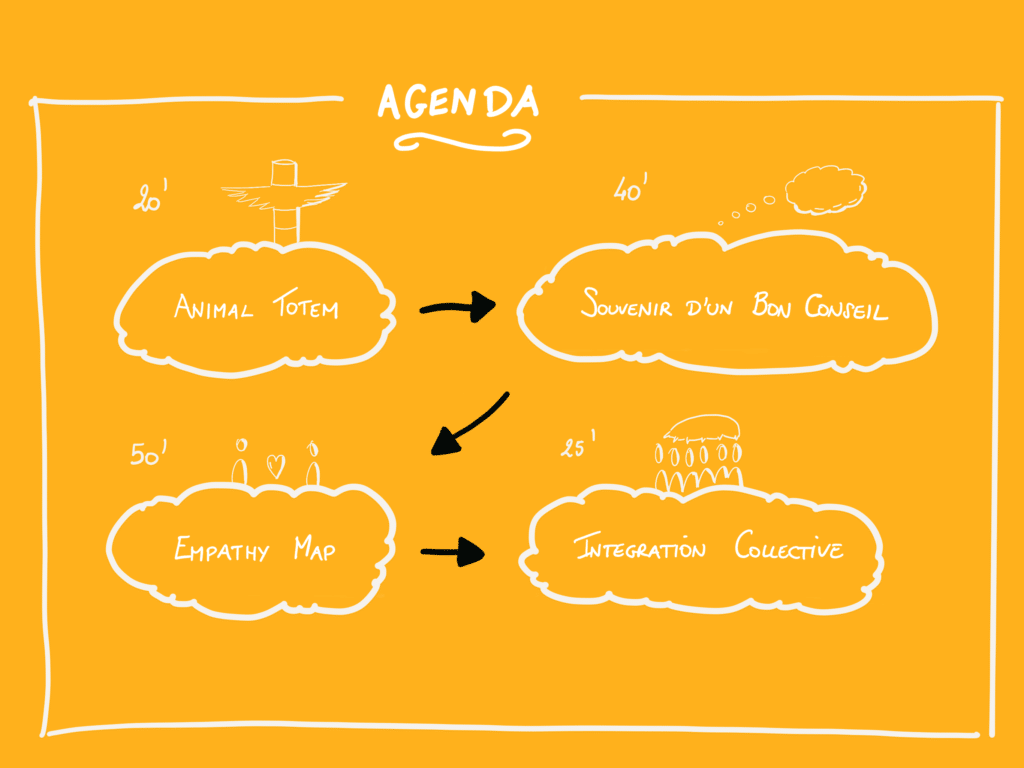
- (20′) Introduction / Icebreaker: Animal Totem
- (40′) Remembrance of good advice
- (20′) Exchange in pairs
- (20′) Collective sharing
- (10′) Break
- (50′) Empathy Map
- (15′) Individual work
- (20′) Exchange in pairs
- (10′) Collective sharing
- (25′) Integration between peers
- (15′) Reflection in 3 sub-groups of 3
- (10′) Collective sharing
- (10′) Closing
In design, we are therefore at 2h35 of content for a planned duration of 3h. Considering a potential delay at the beginning, the possible overflows of the sections and the latency times of the transitions, this seems rather coherent to me.
I propose to you to see starts it really happened now! 😉
Actual process
Animal Totem
For this first part, I leave the hand to Mathilde who supports the animation. This allows me to observe the group quietly! 😉
There are different ways to animate Animal Totem, of course, but here is the one Mathilde chose:
- Place people in a circle so they can all see each other
- Ask each of them to write on a post-it an animal name and an adjective that represents them. It is the combination that interests us.
Note: Remember to use similar markers to avoid recognizing people too quickly 😛
Note: Some people sometimes have trouble finding an animal, so one way is to ask them if an animal inspires them, evokes something positive in them. This can help them position themselves 😉
Here are some examples that emerged from the group: wild tiger, versatile bear, thoughtful bull, impulsive cat…
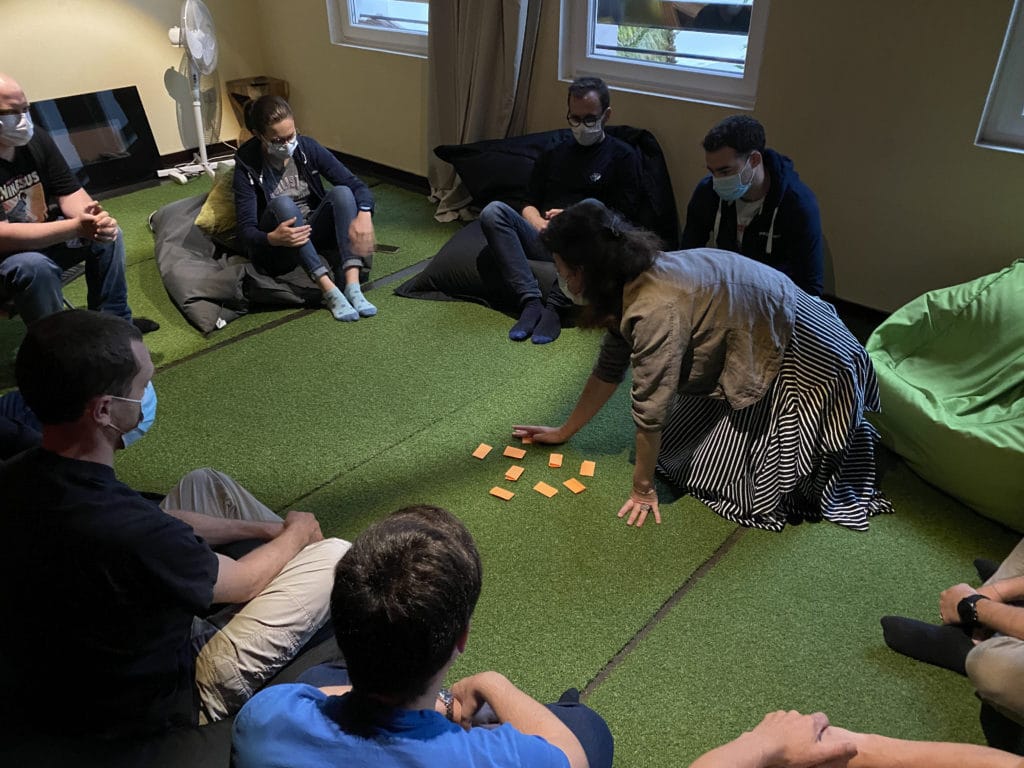
- We fold the post-its into 4 and bring them together in the centre.
- We mix them up a bit and each person picks up a post-it and keeps it in hand if it's not theirs. If not, she puts it back and draws another one.
- Then, each in turn, each person will reveal the totem animal from their hand out loud and give the post-it to the person they think matches. No response requested at this time.
Note: Several post-its can therefore be given to the same person. We'll just make sure afterwards that only one post-it remains per person by reallocating the others collectively.
- When all the post-its have been distributed, we go through each of the people who will validate or invalidate the totem animal that has been assigned to them.
We can then leave room for some exchanges and discussions that will naturally emerge 🙂
This is also what is happening for this group which realizes that they know each other rather well while some of them only arrived a few months earlier!
Debriefing
The atmosphere is relaxed, Mathilde brings some elements of debriefing to which I add some complements :
- Learn to getting to know someone is often done over time because patterns are noticeable and allow us more easily to predict their behavior (both positive and less positive).
- When we have a better idea of what is important for someone it is easier toadapt their behavior to help out if needed.
- So every person is different even if certain main principles can be applied to the greatest number.
- Even if you haven't known the person for a long time, we always have an opinion. It is therefore in exploration that we will validate or invalidate our hypotheses. There is therefore a certain effort to be made to deepen the relationship.
Remembrance of good advice

In this part, I then ask the participants to remember an experience in which they had received good advice and to discuss it in pairs. The pair seemed to me well suited to allow a more intimate and I hope more authentic.
To facilitate the process, I decided to prepare the little poster above beforehand. There are described the course of the sequence with the description of the roles but also a set of questions to help the discussion.
Indeed, I thought that a little help could be useful to go further in sharing stories. I therefore proposed questions in order to target certain criteria such as:
- THE context or situation at the origin of the request for assistance,
- I'welcome proposed by the interlocutor,
- her posture,
- the type of communication used
- there Steps implemented to meet the need,
- how the exchange went fence
And in addition, the magic question of the coach: " What else ? » 🙂
The group being an odd number, Mathilde therefore joined the group to live the experience from the inside! 😉
Testimony of Mathilde
So I found myself in pairs with one of the participants. We quickly and easily found an example of good advice received recently.
My buddy started first and thanks to the interview frame, it was easy to unfold his memory of good advice. His answers were very specific and I started to pick up key words on post-its. The information given was very complete and rich. I was impressed by the amount of information that could be extracted from this memory!
Then it was my turn to share some good advice I received the day before! My partner, spontaneously, began to complete and select post it notes that I had written by cross-checking the information.
Finally, we noted with astonishment that many basic elements were common to us while our experiences were very different at first sight. We selected only the common post-its and joined the group.
At the end of the debrief, when Olivier asked us on which axis we wanted to progress, I chose: “take the time to answer”.
What struck me the most in the elements brought by Olivier: the notion of CHOICE.
Facilitation
During this exchange phase between pairs, I first made sure that each group succeeded in to start up. Indeed, finding the memory was not always easy and I therefore offered to keep it simple taking a situation in which they needed help because they were not able to manage on their own (such as a call to a hotline for an internet or electricity problem, etc.).
Each group having started well, theobserving, listening and timing were my main points of attention:
- Observation to make sure the pair was good concentrate and connected,
- listening not to be indiscreet (because the work in pairs was precisely done so that the discussion remained between the 2 people concerned) but mainly to make sure that theexercise was included
- and finally the timing to keep an eye on the general structure.
Debriefing
The full group debriefing was very rich and despite 10 personal and specific stories, common patterns did emerge.
Here are the elements that emerged from the group:
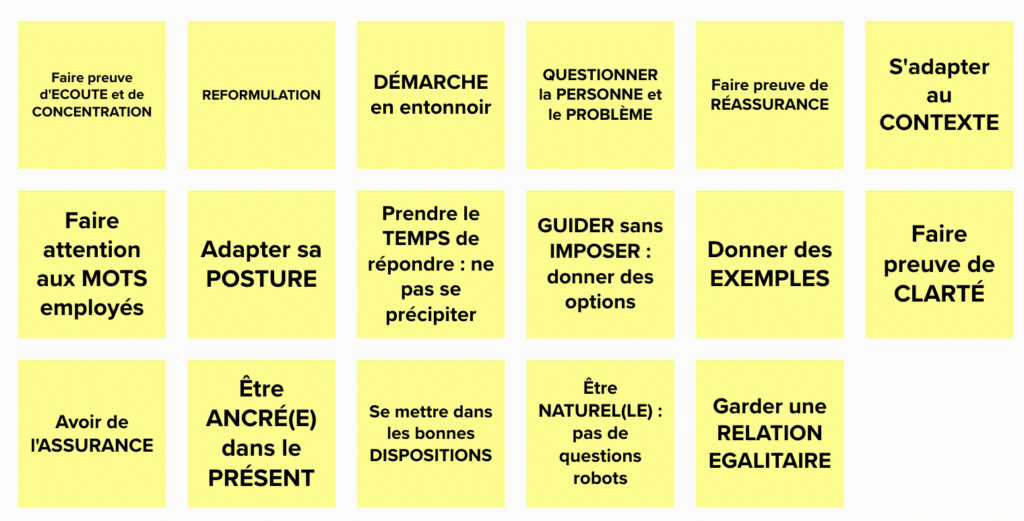
Seeing this list, we can say that they have worked well! 😉
Now, the list being particularly long and not wanting them to get scared, I invited each person to select one of the criteria from the list on which they would like to progress before moving on to a well-deserved break! 🙂
Empathy Map
Back from the break, I introduce this section by talking about what we did before:
- Animal Totem was intended to make us aware of true customer knowledge
- THE remember good advice was made to talk about the relationship to the other
We are now going to repeat these 2 steps but on a concrete case. So we start with customer knowledge with theEmpathy Map.
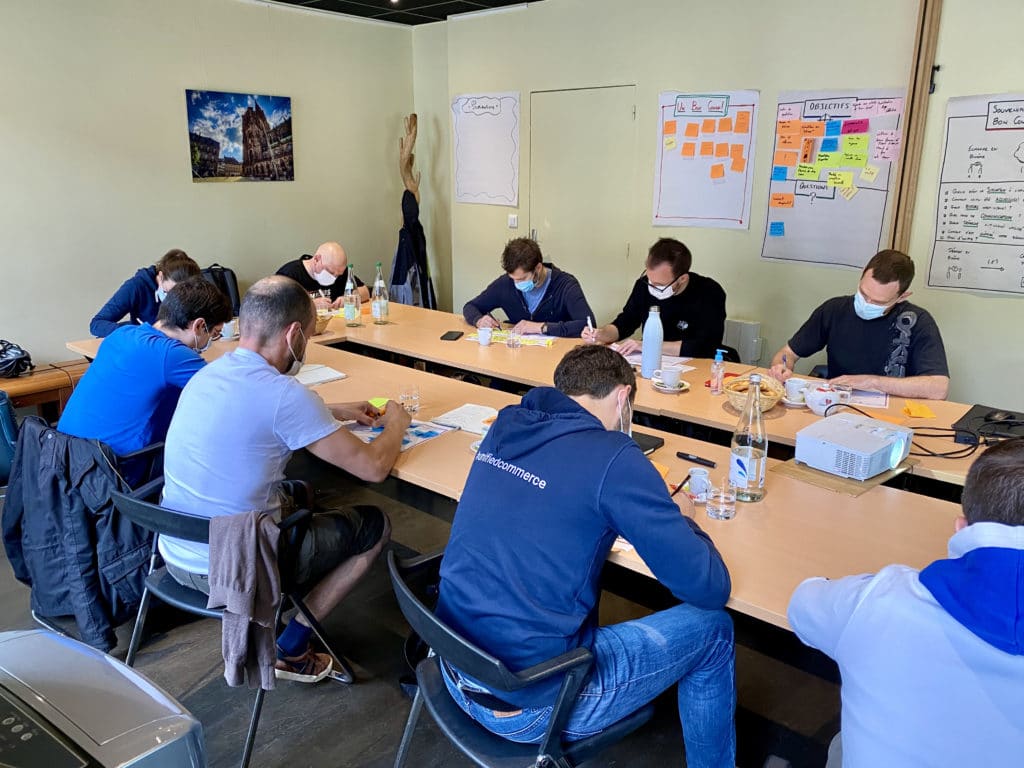
Mathilde having prepared printed A3 copies, we distribute one per participant.
Without so much further explanation, I invite each person to think of a specific client or person to study and complete the canvas.
Note: There is actually no obligation to choose a client, but here we are! 😛 Some participants have selected colleagues from other teams with whom they sometimes interact, for example. The important thing is simply to have a subject of study.
Facilitation
The group is studious and silent. I carefully follow the filling of the different canvases: some are faster than others, with more or less detail. I can feel that some questions bring more difficulty but the reflection is there.
A few minutes from the end of the scheduled time, the canvases are generally a little more than half full. Since this seems important to me and that the participants seem to be well concentrated, I decide to give them one or two more minutes to allow them to see all the questions.
Exchange in pairs
After completing their canvas, I invite the group to divide into pairs and as a reminder of good advice to isolate themselves to discuss.
Each person therefore has the task of presenting the subject of his or her canvas to the other and seeing how he or she would apprehend the relationship. It is a disguised form of advice but above all a cooperation of the 2 parties that we seek to obtain.
Note: We are therefore well into the second phase of the contextual iteration by working on a more specific relationship.
Facilitation
In terms of facilitation, nothing special to report because the group has already experienced this mode of operation. The pairs seem to work well overall, so I let them have some breathing space in their exchanges.
I therefore focus above all on ensuring that the groups start and that the participants remember to switch in due time.
Debriefing
Testimony of Mathilde
Part One: Empathy Map
What amazing exercise ! I lent myself to the Empathy map with a little apprehension I must say…all these boxes to fill in seemed a bit school at the beginning.
I chose to paint the portrait of a colleague. Quickly I realized that some boxes were very easy to fill but others…much less!
First thought : I base myself on certain axes only to apprehend my collaborator! I lack information to really know it!
Second part: In pairs, his turn
The 2nd part of the workshop puts me in duet with a participant of the group. He begins to introduce me to his “target” client and his Empathy map. I feel the rubbing and friction he may have with this person, but I also see that the matrix forces him to some objectivity which changes his perception.
After listening, I spontaneously provide my perception and advice to my partner. My sentences begin with " Me what I will do in this kind of case is…. “, “ what I hear from this person is….“, “ have you tried this with this person?“. Delighted to see my buddy, their face lit up, telling me: " But what a great idea! I never tried to do this“. And what sense of accomplishment for me to have had the impression of lavishing "good advice".
Part two: In pairs, my turn
Then comes my turn to introduce my collaborator via the matrix...the exercise is a bit long, we beg Olivier to give us more time 😉 My partner, himself a manager, will in just a few minutes give me his vision of my colleague (who of course he has never seen): it's dazzling. Then he in turn gives me ideas for improving my relationship with him: I am truly blown away by the accuracy advice that I hadn't considered myself at all! We come back with the group a little stunned to debrief.
The power of the workshop is amazing : the next day I put EXACTLY applying the advice received during the workshop and the results are very convincing! Total success for me and what learning
Here are a few elements brought up by the group during the collective sharing:
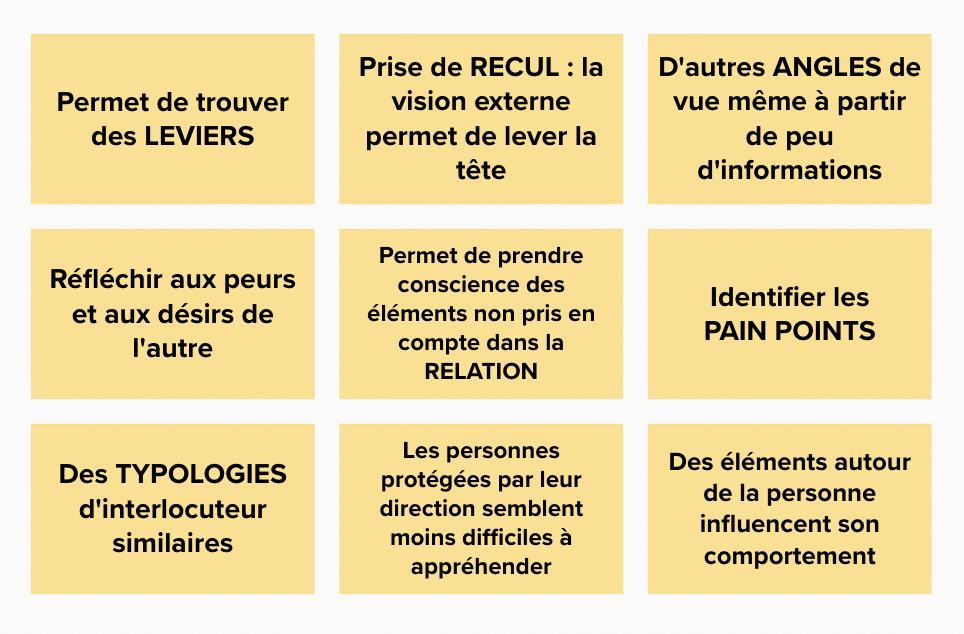
Peer integration
I then invite the participants to form groups of 3 and discuss what they remember from this half-day.
Here's what came out of it:
Animal Totem
We know each other pretty well!
Advice
Our game framework does not exist, it would be worth doing a workshop on this subject.
I identified areas for personal and collective improvement to bring more value to our customers. We could go back to the list, focus on 1 point and improve it! (Who said Agility? :-P)
We could offer several contacts to customers, this would allow us to work on the interchangeability of our team.
Give several options and adapt your posture to the client
The list is scary, we should tick boxes to reassure ourselves because there are many things we are already doing!
We already know these elements but in the implementation it is different!
Empathy Map
Be careful not to give too many details that would lead to over-interpretation. The idea is not to influence too much.
Having another person's vision helps to take a step back.
We could do it on other profiles. It is a support that evolves over time.
It's not easy to put yourself in someone else's shoes!
Conclusion

The design and animation of this thematic half-day was particularly enriching for me. It's a subject that I only very rarely broach, but which seems to have had a certain impact.
More than superficial discussions, I could feel a real questioning of certain people on their modes of operation and a want to do better to bring more value to their customers.
Looking back, I think it's important to don't just respond to a request expressed by a client but to learn to put into perspective compared to what we know how to do best, with the farm intention to provide maximum value.
The participants seem to have been satisfied, Mathilde and me too, so it deserved to be shared in case it could be useful! 🙂
PS: Don't hesitate to stop by and see what Matilda done while you're at it 😉

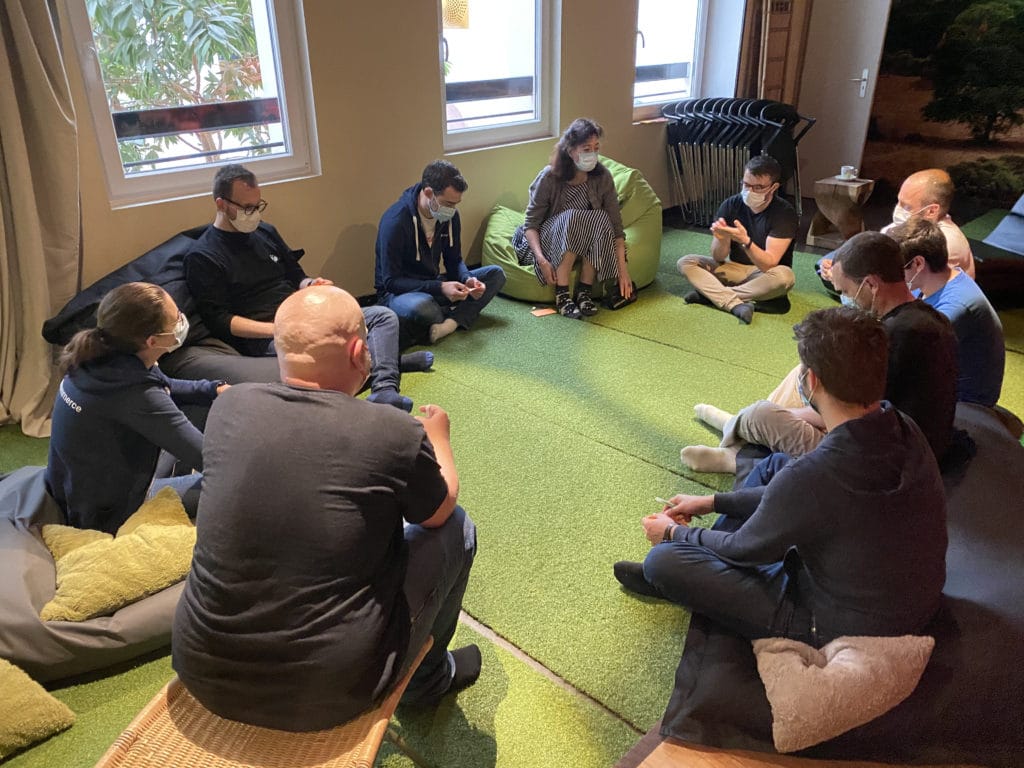






4 responses
Hello Olivier, this article allowed me to spend a few pleasant minutes by satisfying my curiosity to find out how you answered this initial request. The article is very clear and detailed which made it an excellent source of reflection for me. Many thanks for sharing this.
Hello Peter,
Thank you very much for your message !
This encourages me to continue producing this kind of content!
Have a nice evening.
Olivier
Thank you for this article!
Super unfolding, and very concrete explanations, it's great, thank you so much!
Hello Florence,
Thank you very much for your message 🙂
Beautiful evening.
Olivier